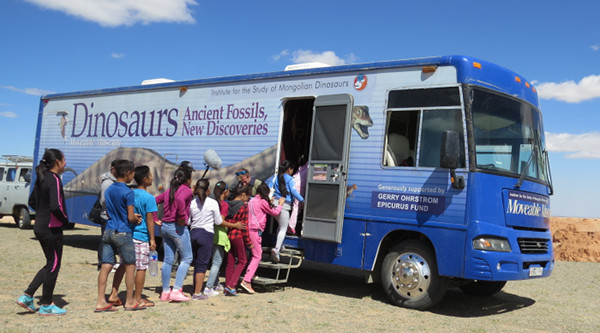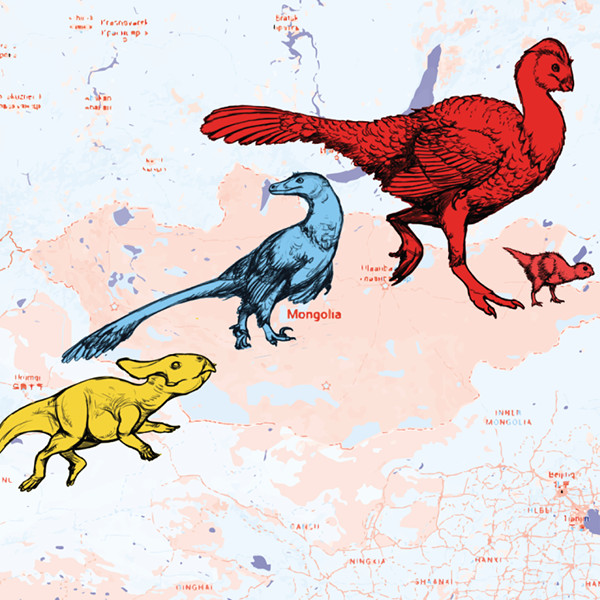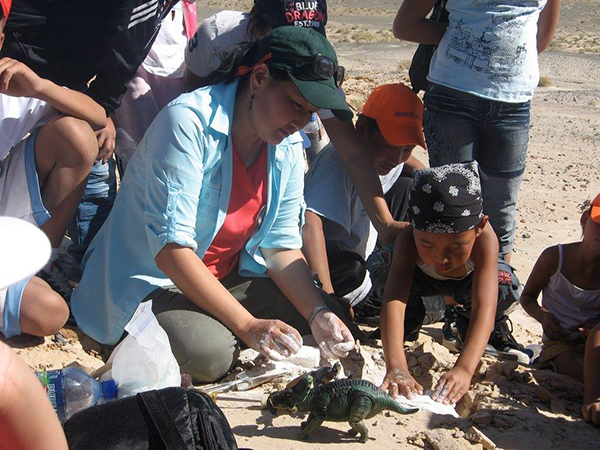
by Thea Boodhoo Friday, June 24, 2016

Children visit the Institute for the Study of Mongolian Dinosaurs mobile museum in 2015 during ISMD's first outreach trip through Mongolia in 2015. Credit: ©Institute for the Study of Mongolian Dinosaurs
In the time of_ Velociraptor_, 80 million years ago, southern Mongolia looked surprisingly like the Gobi Desert that exists there today. Animals roamed, nested and fought amid an arid climate while sand-soaked winds battered rocky outcrops. Today, walking along the Flaming Cliffs of Bayanzag, you may only notice one stark difference: Where Velociraptor and other dinosaurs once thrived, there are now only a few fossilized remains. And even those are endangered.
Because of this, a small team of scientists, hired staff and volunteers — I’m one of the latter — is heading to Mongolia this fall to try to save them. Unlike similar fossil-rich locales in the U.S., like Dinosaur National Monument in Utah or the La Brea Tar Pits in California, Bayanzag has no museum, no visitor center, no on-site staff and no year-round protection. This leaves the extraordinary fossils of Protoceratops,_ Oviraptor_,_ Pinacosaurus_ and others vulnerable to weather, poaching and accidental damage, and it leaves local communities without resources to protect them or a means to benefit from an increasingly popular tourist attraction and scientific resource. The same story can be told at other important fossil sites across Mongolia.

Late Cretaceous dinosaurs of Mongolia: from left to right, Protoceratops, Velociraptor and Oviraptor. Credit: ©Institute for the Study of Mongolian Dinosaur
Mongolian paleontologist Bolortsetseg Minjin is working to change this. Initially supported by the Museum of the Rockies in Bozeman, Mont., she founded a nonprofit organization called the Institute for the Study of Mongolian Dinosaurs (ISMD) with a mission to “develop a self-sustaining active community of Mongolian paleontologists and a museum in Mongolia to preserve dinosaurs and other national treasures for generations to come.” Since 2007, the ISMD has helped repatriate 31 illegally exported dinosaur fossils and held 25 outreach events in Mongolia and the U.S., promoting paleontological knowledge, fossil conservation techniques and an appreciation of scientific thinking and deep time.
The group’s work has received praise from the Mongolian government as well as the paleontology community. “It’s awesome to see this initiative taking shape. I grew up in a fossil-rich rural area myself — in South Dakota — and I’m glad to see anything that fosters appreciation and access by rural people worldwide,” says Andrew Farke, director of research and collections at the Raymond M. Alf Museum of Paleontology in Claremont, Calif., who is not involved in the project.
In 2013, New York’s American Museum of Natural History donated a mobile dinosaur museum to the cause. After crossing half the world to get to Ulaanbaatar, the exhibit-filled tour bus had its first successful outreach expedition last year. Funded by an Indiegogo campaign and donations from private philanthropist Gerry Ohrstrom and the Epicurus Fund, Bolortsetseg brought the mobile museum to Bayanzag, where children who live near one of the world’s most important dinosaur quarries could learn, for the first time, about the creatures discovered there.
Now, the ISMD is planning its most ambitious outreach effort yet: a month-long mobile museum expedition this fall to Ulaanbaatar, Bayanzag and Western Mongolia, with a team of American and Mongolian collaborators. Bolortsetseg says she hopes the effort will help prevent fossil poaching by educating local communities near important quarries on the long-term economic and educational benefits that publicly accessible fossils can have, and help protect fossils that become exposed through accident or erosion by teaching methods of fossil conservation to area residents who can use them year-round. While on tour, we also plan to engage locals on the topic of a permanent museum near Bayanzag that could serve as a center of research, learning, conservation and community gathering.

Paleontologist Bolortsetseg Minjin talks with a group of children about fossil conservation during an outreach event near Bayanzag. Credit: ©Institute for the Study of Mongolian Dinosaurs
Because the mobile museum was constructed in the U.S. for English-speaking audiences, none of the exhibits are currently in Mongolian. Translation is one of a suite of outreach expenses budgeted into a new crowdfunding campaign the ISMD is launching today. Other expenses include transportation, room and board for the team, artwork of Mongolian dinosaurs for educational materials, a Mongolian/English website for Bayanzag tourists and locals, and potentially, a campaign of leave-behind fliers designed to discourage fossil poaching.
_Velociraptor _will never roam the Mongolian landscape again, but through the efforts of Bolortsetseg Minjin and the volunteers of the ISMD, its remains will hopefully last long enough in the wild to grace the halls of a modern museum in the Gobi.
To help fund the ISMD’s 2016 outreach expedition, visit the campaign page at: https://igg.me/at/mongoliandinos
*Update (7/3/16, 9:50 am EDT) The Epicurus Fund was previously identified above as a “Mexico-based investment firm.” However, the Epicurus Fund that provided support for the ISMD is a separate entity and is not affiliated with the similarly named firm based in Mexico to which this article referred. The text has been changed to reflect this correction.
© 2008-2021. All rights reserved. Any copying, redistribution or retransmission of any of the contents of this service without the expressed written permission of the American Geosciences Institute is expressly prohibited. Click here for all copyright requests.